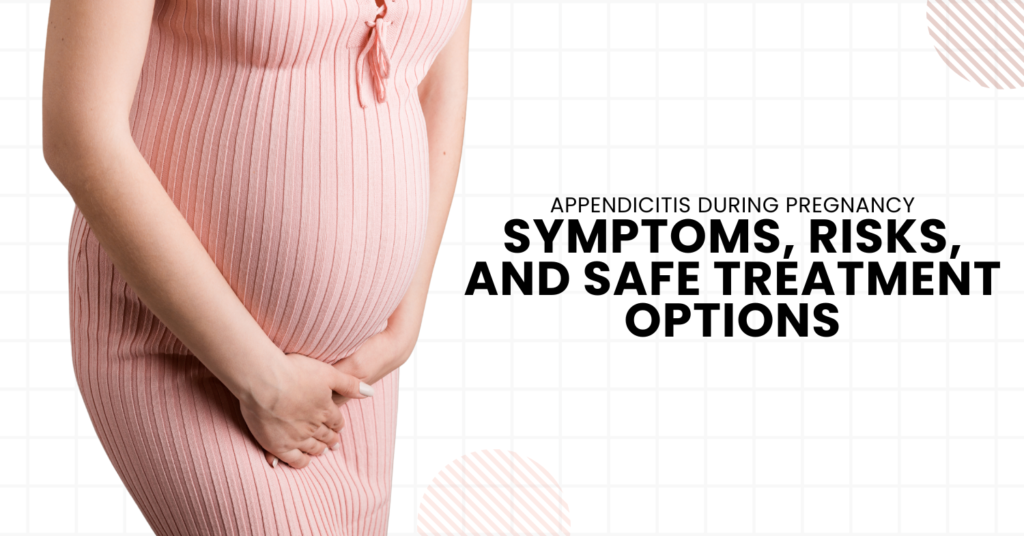Appendicitis During Pregnancy: Symptoms, Risks, and Safe Treatment Options

Introduction
Appendicitis during pregnancy is a medical emergency that affects 1 in 1,500 pregnancies. While rare, it’s the most common non-obstetric surgical condition during pregnancy. Delayed diagnosis can lead to severe complications like preterm labor, miscarriage, or life-threatening infections. In this blog, we’ll explore the unique challenges of appendicitis in pregnancy, safe treatment options, and how to protect both mother and baby.
Why Appendicitis Is Dangerous During Pregnancy
The growing uterus shifts the appendix upward, making pain location atypical and diagnosis harder. Hormonal changes also mask symptoms like nausea, while leukocytosis (high white blood cell count) is normal in pregnancy. Key risks include:
- Perforated appendix (rupture rate: 14–43% in pregnancy vs. 10–20% in non-pregnant patients).
- Premature labor (11–33% risk if untreated).
- Fetal loss (up to 36% if the appendix ruptures).
Symptoms of Appendicitis in Pregnant Women
Symptoms often mimic normal pregnancy discomfort, but key red flags include:
- Abdominal pain starting near the belly button and shifting to the right upper quadrant (due to the appendix moving upward).
- Nausea/vomiting that worsens over time (not typical “morning sickness”).
- Fever (≥100.4°F) and chills.
- Loss of appetite and bloating.
Atypical Signs:
- Back pain or urinary discomfort (if the appendix presses on the bladder).
- Pain with movement (walking, coughing).
Diagnosis Challenges
Pregnancy complicates diagnosis due to:
- Ultrasound limitations: The appendix is harder to visualize as the uterus grows.
- MRI as a safe alternative: No radiation, 91% accuracy in detecting appendicitis.
- Avoiding CT scans: Radiation risks to the fetus, though low-dose protocols exist for emergencies.
Treatment Options
- Laparoscopic Surgery:
- Safe for mother and baby: Minimally invasive with smaller incisions.
- Success rate: 95% with minimal complications when performed by experienced surgeons.
- Modifications: Left lateral positioning, lower CO₂ pressure (<12 mmHg).
- Antibiotics (Rare for mild cases):
- Used only if surgery is high-risk (e.g., severe heart disease).
- 70% short-term success, but 30–40% recurrence risk.
- Open Surgery:
- Required for ruptured appendix or severe infection.
- Higher risk of preterm labor but life-saving.
Risks to the Baby
- Premature birth: 15–33% risk if surgery is delayed.
- Low birth weight: Linked to maternal infection and stress.
- Miscarriage: Rare (1–2% with timely surgery).
Key Fact: Fetal mortality jumps from 2% (uncomplicated appendicitis) to 36% if the appendix ruptures.
FAQs
Q: Can appendicitis harm my unborn child?
A: Yes, if untreated. Infection from a ruptured appendix can spread, increasing preterm labor or fetal loss risks.
Q: Is appendectomy safe in the third trimester?
A: Yes. Laparoscopic surgery is safe up to 36 weeks. After 36 weeks, a C-section may be combined with appendectomy.
Q: Can I avoid surgery with antibiotics?
A: Rarely. Antibiotics alone risk recurrence and complications. Surgery remains the gold standard.
Risks to the Baby
- Premature birth: 15–33% risk if surgery is daelayed.
- Low birth weight: Linked to maternal infection and stress.
- Miscarriage: Rare (1–2% with timely surgery).
Key Fact: Fetal mortality jumps from 2% (uncomplicated appendicitis) to 36% if the appendix ruptures.
Conclusion
Appendicitis during pregnancy demands urgent care. Trust your instincts—if you experience severe abdominal pain, seek help immediately. Modern treatments like laparoscopic surgery are safe and effective, protecting both you and your baby. Don’t delay—early action saves lives!
